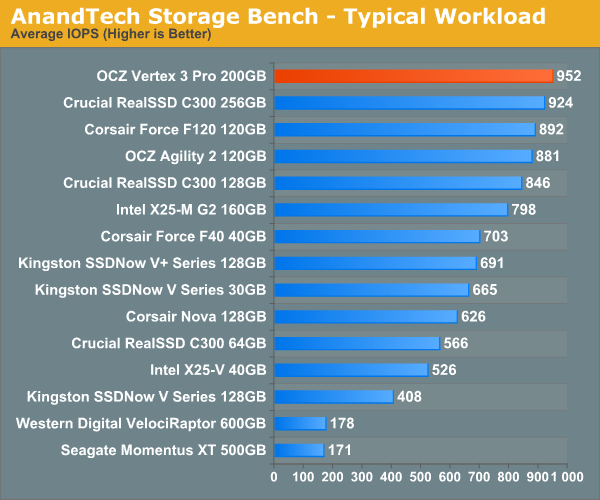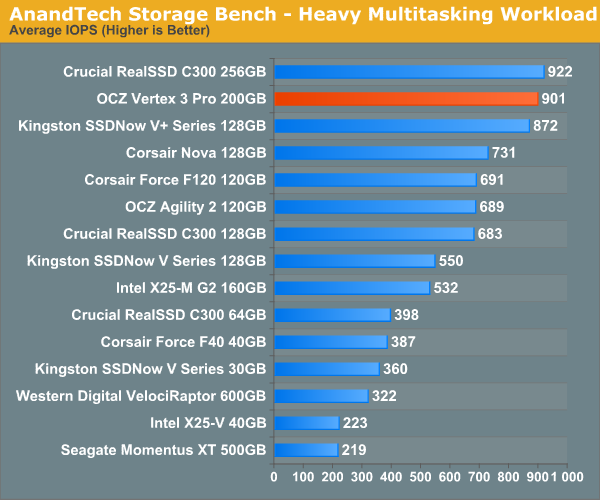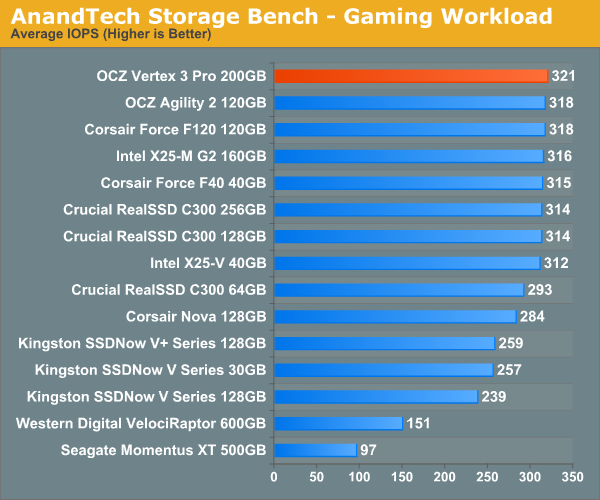OCZ Vertex 3 Pro Preview: The First SF-2500 SSD
by Anand Lal Shimpi on February 17, 2011 3:01 AM ESTAnandTech Storage Bench 2010
To keep things consistent we've also included our older Storage Bench. Note that the old storage test system doesn't have a SATA 6Gbps controller, so we only have one result for the Vertex 3 Pro (and the C300). The SF-2500 controller does respectably here, but with a 3Gbps controller we're only marginally faster than other SSDs (which is why we've moved to a new storage platform for 2011).
The first in our benchmark suite is a light/typical usage case. The Windows 7 system is loaded with Firefox, Office 2007 and Adobe Reader among other applications. With Firefox we browse web pages like Facebook, AnandTech, Digg and other sites. Outlook is also running and we use it to check emails, create and send a message with a PDF attachment. Adobe Reader is used to view some PDFs. Excel 2007 is used to create a spreadsheet, graphs and save the document. The same goes for Word 2007. We open and step through a presentation in PowerPoint 2007 received as an email attachment before saving it to the desktop. Finally we watch a bit of a Firefly episode in Windows Media Player 11.
There’s some level of multitasking going on here but it’s not unreasonable by any means. Generally the application tasks proceed linearly, with the exception of things like web browsing which may happen in between one of the other tasks.
The recording is played back on all of our drives here today. Remember that we’re isolating disk performance, all we’re doing is playing back every single disk access that happened in that ~5 minute period of usage. The light workload is composed of 37,501 reads and 20,268 writes. Over 30% of the IOs are 4KB, 11% are 16KB, 22% are 32KB and approximately 13% are 64KB in size. Less than 30% of the operations are absolutely sequential in nature. Average queue depth is 6.09 IOs.
The performance results are reported in average I/O Operations per Second (IOPS):

If there’s a light usage case there’s bound to be a heavy one. In this test we have Microsoft Security Essentials running in the background with real time virus scanning enabled. We also perform a quick scan in the middle of the test. Firefox, Outlook, Excel, Word and Powerpoint are all used the same as they were in the light test. We add Photoshop CS4 to the mix, opening a bunch of 12MP images, editing them, then saving them as highly compressed JPGs for web publishing. Windows 7’s picture viewer is used to view a bunch of pictures on the hard drive. We use 7-zip to create and extract .7z archives. Downloading is also prominently featured in our heavy test; we download large files from the Internet during portions of the benchmark, as well as use uTorrent to grab a couple of torrents. Some of the applications in use are installed during the benchmark, Windows updates are also installed. Towards the end of the test we launch World of Warcraft, play for a few minutes, then delete the folder. This test also takes into account all of the disk accesses that happen while the OS is booting.
The benchmark is 22 minutes long and it consists of 128,895 read operations and 72,411 write operations. Roughly 44% of all IOs were sequential. Approximately 30% of all accesses were 4KB in size, 12% were 16KB in size, 14% were 32KB and 20% were 64KB. Average queue depth was 3.59.

The gaming workload is made up of 75,206 read operations and only 4,592 write operations. Only 20% of the accesses are 4KB in size, nearly 40% are 64KB and 20% are 32KB. A whopping 69% of the IOs are sequential, meaning this is predominantly a sequential read benchmark. The average queue depth is 7.76 IOs.











144 Comments
View All Comments
PubicTheHare - Thursday, February 17, 2011 - link
Anand,Would this be the drive to pair with a Sandy Bridge Macbook Pro, or do we still need to wait for native TRIM support in OSX?
I'm really eager to buy a Sandy Bridge MBP and do this if the V3P is the one to get. I can't recall which controller you recommended for Macs.
markjx1 - Thursday, February 17, 2011 - link
Why no mention of the fact this was originally slated for the SF-2000, and now its got the enterprise class SF-2500 with disclaimers of "hardware not final" all over the article?The truth is they had major problems with SF-2000 and nobody wants to talk about it - of all people I'd think you would have. Now go ahead and delete my post again.
markjx1 - Thursday, February 17, 2011 - link
Resorting to using the enterprise-class SF-2500 means I worry about cost competitiveness against other upcoming Gen3 offerings from Intel and Crucial/Micron.OCZ took a $25 mil bank loan recently so they need a winner. I worry about the "hardware is not final" disclaimers in the article. Sending these samples out for some buzz smells like buying time while they work out production dilemmas since originally they were going to use a different SF controller.
bplewis24 - Friday, February 18, 2011 - link
Why are you trolling? You have 3 of essentially the same posts on this page. We get it, you think he "sold out" for not mentioning that it's using a different controller.Brandon
vol7ron - Thursday, February 17, 2011 - link
Does this mean a higher QD, might improve performance.It looks like QD of 16 might be the sweet spot in terms of latency vs IOPS
DJMiggy - Thursday, February 17, 2011 - link
Thanks for the great article and thank you OCZ for making my Vertex 1 even more obsolete. That's ok though! Not a complaint! lol Just looking forward to my next upgrade!Rasterman - Thursday, February 17, 2011 - link
Since the drive is 400MB/s read, if you use two in RAID-0 are you going to get 800MB/s or the realistic max of 6gpbs of ~700MB/s?If you use RAID-0 X4 are you going to get 1600MB/s or ~700MB/s?
jwilliams4200 - Thursday, February 17, 2011 - link
With a decent RAID card, then RAID 0 of N drives will give you slightly less than N times the performance of a single drive.For on-motherboard RAID, you will also get approximately N times the performance of a single drive, but there is usually a ceiling to total performance on motherboard RAID. It is around 600 MB/s for ICHR-10.
myterrybear - Thursday, February 17, 2011 - link
I've been a loyal reader of this sight, but what realy myths me if you's use EVERY other controler but those found on the AMD platform .... especialy more so with a Sata 6.0 SSD like this it would match up well for those of us amd users whom have paid money to upgrade the motherboard to have that sb8xx controler onboard to utilize hard drives & other devices that run on the now becoming Sata 6.0 standard.Per Hansson - Thursday, February 17, 2011 - link
Hi, has the much talked about hibernation problem with the Sandforce drives been solved in the 2xxx series?Loosing Hibernation is pretty much a deal killer for me in a laptop :(
http://www.google.se/search?hl=sv&safe=off&...